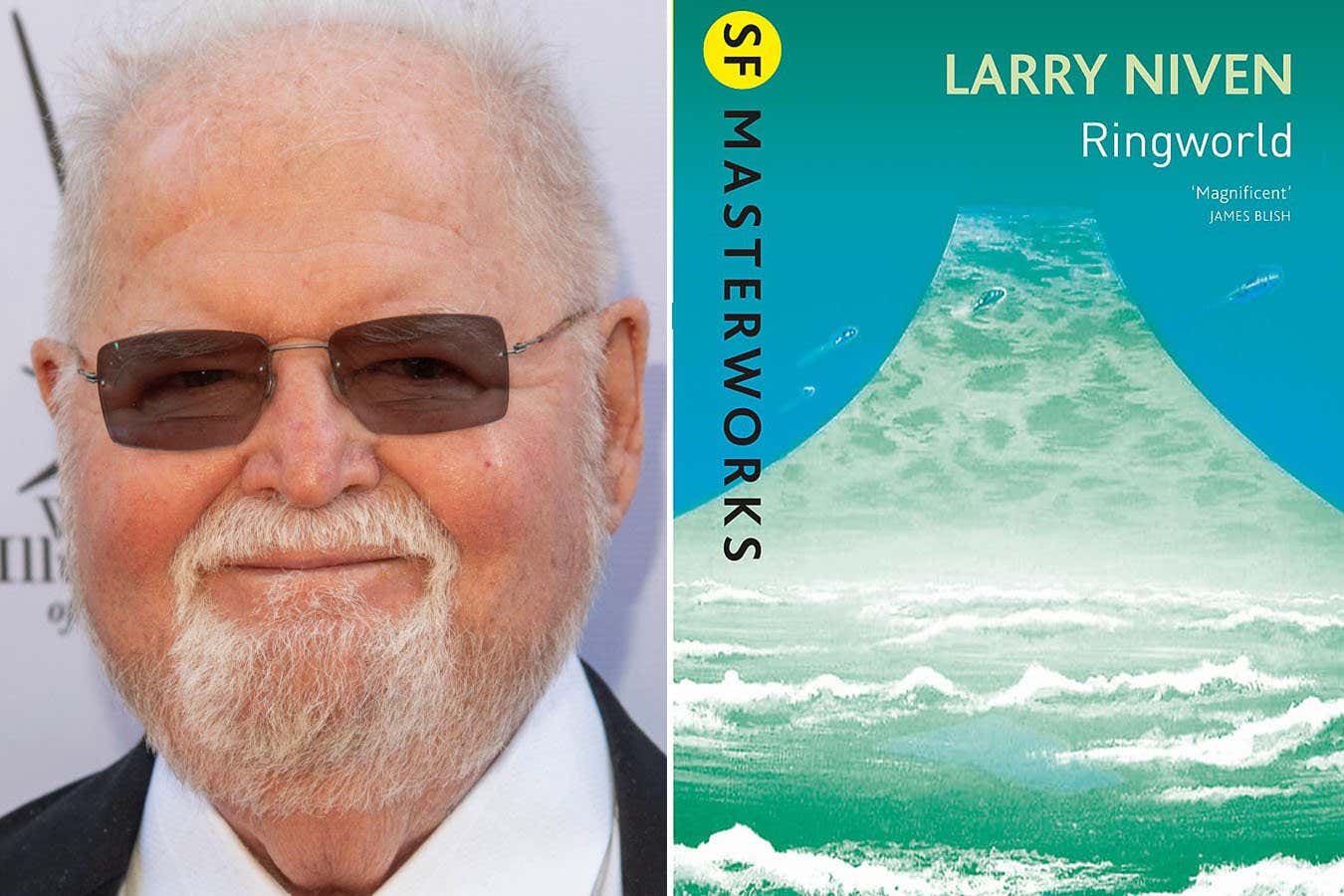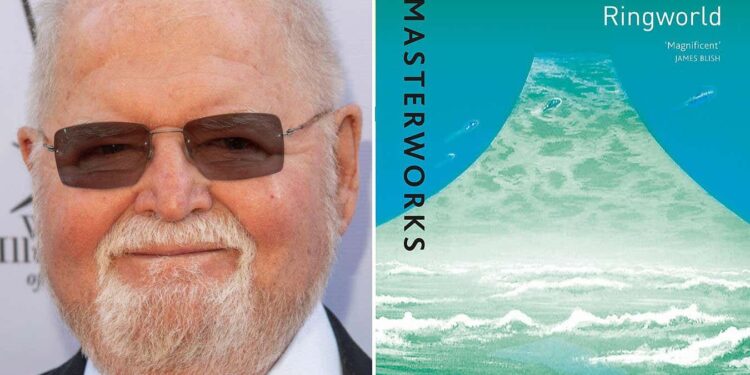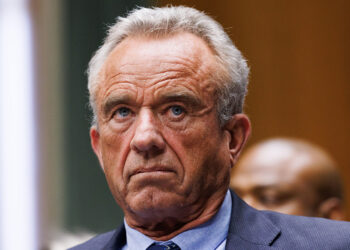
The Book Club gives their verdict on Larry Niven’s Ringworld
Eugene Powers/Alamy
It was quite an experience, moving from the technicolour magical realism of Michel Nieva’s wild dystopia, Dengue Boy, to Larry Niven’s slice of classic science fiction, Ringworld, first published in 1970 and very much redolent of the sci-fi writing of that era. Not a wholly bad experience, mind, but quite a jolting change of pace for the New Scientist Book Club. I was a teenager when I last read Ringworld, and a hugely uncritical sort of teenager at that, so I was keen to return to a novel I remembered fondly and see how it stood up to the test of time – and my somewhat more critical eye.
The first thing to say is that many of the things I loved about Ringworld were very much still there. This is, for me, a novel that inspires awe – with the vastness of its imagination, the size of its megastructures, the distance it travels in space. I was reminded of that awe early on, when our protagonist Louis Wu (more on him later) recalls standing at the edge of Mount Lookitthat on a distant planet. “The Long Fall River, on that world, ends in the tallest waterfall in known space. Louis’s eyes had followed it down as far as they could penetrate the void mist. The featureless white of the void itself had grasped at his mind, and Louis Wu, half hypnotized, had sworn to live forever. How else could he see all there was to see?”
That hugeness, that desire for exploration and knowledge and discovery, is one of the main reasons why I love science fiction. What else is out there, and what can we find out about it? From that field of murderous sunflowers on the Ringworld – what a scene! – to Niven’s image of our crew in space, looking at the bottom of the Ringworld and the huge bulge of a deep ocean protruding towards them, Ringworld has this in spades, and I lapped it up. “A man can lose his soul among the white stars… They call it the far look. It is dangerous.”
I also very much enjoyed how Niven makes us pick up the breadcrumbs of where we are in time and in technological developments; at one point, Freeman Dyson, he of the Dyson spheres that inspired the Ringworld, is described as “one of the ancient natural philosophers, pre-Belt, almost pre-atomic”. I find that sort of thing delightful, and I was also (largely) amused by Niven’s aliens, from the cowering terror of the Puppeteers to the brilliantly named Speaker-To-Animals (we, the aliens, are the animals). I pictured Speaker as a huge version of our large ginger cat, and rather liked him.
As I wrote earlier, though, this is a piece of writing that feels very much of its time, in terms of the somewhat plodding prose and sexist overtones, even if it succeeds (for me) in the wonderful, star-spanning maths and physics of it all. Niven’s characters are pretty one-dimensional. Louis Wu is quite annoying. There could be so much more to Teela, our token woman. And once the crew are on the Ringworld, it all feels a bit “then they went here, then they went there”, rather than being tightly plotted.
There has been some intense discussion about this novel on our Facebook page, and many of you felt similarly. “While I enjoyed it very much, I kept getting pulled out of the interesting scientific aspects of the story as well as the rollicking adventure by the sexist, boys club aspects. It’s a little sad that Larry Niven’s view of the distant future didn’t involve any advancement in men’s views of women,” said Jennifer Marano. “It reminds me of early spy movies. Beautiful woman who hasn’t sense enough to not be enamored by less than interesting or intelligent male with pretty huge ego,” said Eliza Rose.
Alan Perrett was even less impressed with Louis Wu’s behaviour: “I have to admit to finding Louis Wu absolutely creepy. He treats the woman that he professes to love with contempt. He laughs finding out that she’s the result of a eugenics experiment and then, when looking at her, sees her dismay and then keeps laughing. I hope when I’m 200 years old I’ve learned a little more empathy than that.”
Gosia Furmanik grew up reading science fiction from Niven’s era because that was what was available – but “eventually, the sexism and lack of female/diverse protagonists put me off sci-fi for a good 15 years”. She only got back into sci-fi when she discovered “that nowadays it’s easy to find books of this genre written by non-white non-men that don’t have this pitfall”. “Ringworld brought me back, not in a good way,” Gosia writes. “While not as blatant as in some of its contemporaries, cringy sexism nevertheless seeps out of this book.”
It’s definitely true that Teela’s character arc was the biggest issue for most of us with this book. “I loathed the ending of Teela’s story and the explanation of how her luck led her to come on the mission. It seems a woman can’t have a meaningful existence without a man!” wrote Samatha Lane.
Samantha also makes a great point about how “the male human is the most perceptive creature in the universe” created by Niven. “This arrogance about the sheer cleverness of humans stems from traditional humanism which puts humans at the centre of everything – as rational, special, superior beings. Combine that with the recent conquest of space (man landed on the moon the year before) and it’s like a bonfire of the collective ego,” she writes.
Onto the positives, however: Niall Leighton “enjoyed the sheer scale of the novel” and thinks it hasn’t “dated as badly as much science fiction of this era”, while for Andy Feest, “the science was probably the most interesting thing” (he found the characters “unenjoyable” and the chauvinism “a bit jarring”).
Some readers approved of Niven’s heavy hand with the maths – it “definitely added to my enjoyment”, wrote Linda Jones, while Darren Rumbold “especially liked” the Klemperer rosettes. It didn’t work for all of you, though: Phil Gurski “was excited to read this classic sci-fi novel and really, really wanted to enjoy it but the technobabble kept getting in the way. I found it hard to keep up.”
Overall, I think the book club found it an interesting exercise to dig into this science fiction classic and hold it up to the light of today. I think we’ll do another classic soon enough, and I’m listening to suggestions from readers who have tipped books by Ursula K. Le Guin, N. K. Jemisin and Joanna Russ as possible palate cleansers.
Next up, though, is something a little more modern: Kaliane Bradley’s bestselling time travel novel, The Ministry of Time. Yes, it has a woman as its protagonist, and yes, it passes the Bechdel test. You can read a piece by Kaliane here in which she explains why (and how) she wrote a novel about time travel, and you can check out this fun opener to the book here. Come and read along with us and tell us what you think on our Facebook page.
Topics:
Source link : https://www.newscientist.com/article/2481268-our-verdict-on-ringworld-by-larry-niven-nice-maths-shame-about-teela/?utm_campaign=RSS%7CNSNS&utm_source=NSNS&utm_medium=RSS&utm_content=home
Author :
Publish date : 2025-05-30 09:05:00
Copyright for syndicated content belongs to the linked Source.














